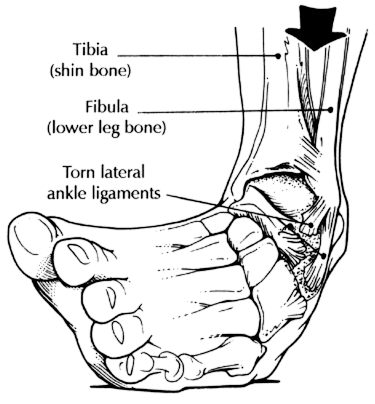Physio Blogfrom the team at South Coast Physiotherapy

Guy Agutter
Ankle Sprains - By Guy Agutter
Ankle sprains (aka “the rolled ankle”) present as the most common musculoskeletal injury in active populations and one we as physiotherapists see often. A sprain involves damage to the ligaments between the bones surrounding the ankle, and this is most commonly on the lateral side as these ligaments are not as strong as those on the inside of the ankle. Furthermore it is less common for us to roll our ankle ‘out’ compared to rolling our ankle ‘in’.
Almost everyone has had these injuries at some point throughout their lives, and depending on the severity of the injury some may have healed completely or some people may have suffered ongoing ankle issues since.
Pourkazemi et al. (2014) suggests that in the year following an ankle sprain you’re greater than two times more likely to re-injure the same ankle, with rates greater in those higher risk sports like basketball. Therefore it is crucial to follow a full rehabilitation program to help reduce these rates of recurrence and get yourself back to full function as soon as possible.

Injury Severity
The degree of injury can generally be evaluated by your physiotherapist and can help us determine your return to sport or everyday function. These are:
Grade 1 - Mild tear to the ligament.
Grade 2 - Moderate tear of the ligament.
Grade 3 - Severe tear or complete rupture of the ligament.
Pain and swelling is generally localised to the injured ligament however initial swelling may make this less clear. The pain is worse with weight bearing and can generally be palpated by the physiotherapist. If the pain is higher up the ankle or lower down the foot you can suspect a differential or additional diagnosis. Pain is generally a poor predictor of the injury grade especially early in the recovery period.
How Should We Treat This?
Commonly people suffering these injuries will let them run their course and not seek professional management. This is understandable as the injury may appear minor however it is worth being aware that this can lead to subsequent ankle injuries and degenerative changes such as osteoarthritis in the future. Often if left untreated the individual may suffer with “Chronic Ankle Instability” - a condition characterised by decreased ankle stability, strength and recurrent swelling which will then place the individual at further risk of ongoing pain and dysfunction.
Initial treatment should begin as soon as the injury occurs. If the injury was non-traumatic you can begin by resting your ankle and placing an icepack on it for 20 minutes every 2-3 hours. This can coincide with gentle ankle movements in a non weight-bearing position as your pain allows. You should then book in to see your physiotherapist so that they can correctly diagnose your injury and rule out other potential conditions. Research is now showing there is no added benefit from additional modalities such as bandaging and elevation however if this provides pain relief then it may still be promoted (Fong et al. 2009).
From here you will be given an exercise program by your physiotherapist to maintain strength and mobility in your ankle as it heals. Balance and dynamic exercises are crucial to allow your ankle to regain its ability to stabilise in different positions (Vuurberg et al. 2018). Furthermore your ankle will benefit from bracing or taping for 2-12 months following injury to prevent the risk of recurrent injury (Vuurberg et al. 2018) . This is especially relevant for those playing competitive sport.
If you have any questions call South Coast Physiotherapy on (03) 5985 9055 to book an appointment today.